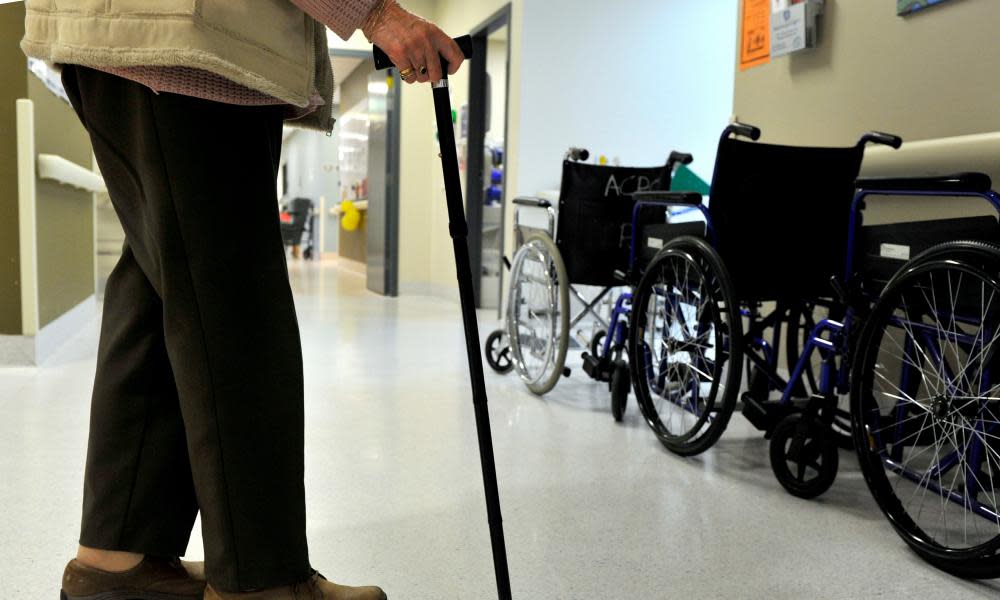Aged care sector wants Covid prevention funding restored as 30% of homes grapple with outbreaks

The aged care sector has urged the government to reinstate Covid prevention funding as it grapples with outbreaks in almost 30% of the nation’s residential facilities.
The call comes as aged care workers in South Australia and Queensland prepare to walk off the job over unfair pay and conditions.
Last year, the government withdrew temporary financial support designed to help the sector manage the cost of deploying measures to prevent outbreaks at their facilities, including the purchase of personal protective equipment and rapid tests.
The government instead established a grant program that allowed providers to apply for money to reimburse the costs of managing the direct impacts of a Covid-19 outbreak in their facility.
But the sector has now claimed the new grants scheme has created a “perverse” situation, where providers who successfully avoid outbreaks, including by spending significant amounts on prevention, are punished financially.
Related: Aged care workers across Australia vote to take industrial action
The problem was raised in a detailed report by the University of Technology Sydney Ageing Research Collaborative this week, which warned providers which were “proactive in managing infection control and are successful in avoiding outbreaks” were “unable to recoup this additional expenditure or losses of revenue through access to grants or subsidies”.
The report found the withdrawal of temporary financial supports from the earlier stages of the pandemic had contributed to a torrid six months financially for aged care providers. The overall net deficit in Covid-related expenses was $196,000 per provider for the six months from July to December last year, the report found.
It found more than 60% of residential aged care homes were currently operating at a loss.
The Aged & Community Services Australia chief executive, Paul Sadler, said the current funding system was creating a “perverse incentive” that rewarded providers who experienced an outbreak. The loss of the early-stage temporary funding for Covid prevention, he said, had contributed to the dire financial situation of many providers.
“Basically, we’re spending more money on trying to prevent Covid getting in than we’re getting back from the government, even if you’ve been able to get money back through the grants program,” Sadler said.
“What we’ve been asking for through the [Australian Aged Care Collaboration], we talked about a workforce supplement being our first ask, so it’s short-term funding relief, and we included in that ask a request for a reinstatement of the Covid prevention component to the funding.”
The most recent data paints a bleak picture of the ongoing impact of Covid in aged care, particularly in the early stages of 2022. The sector had reported 1,418 Covid deaths this year, already more than the two first years of the pandemic combined.
There were 761 active outbreaks. About 3,300 aged care residents and 1,999 staff were Covid-positive in the last data released by the government.
The United Workers Union said its members would strike in South Australia and Queensland on Friday, one day before the federal election, walking off the job over unfair pay and conditions.
The major parties go to polling day with significant differences in their aged care policies, but the sector says neither has announced enough to address the immediate problems it faces.
Labor has promised registered nurses will be on site 24/7 in every residential aged care facility in the country. It will also mandate that every resident receives an average of 215 minutes of care a day, as recommended by the aged care royal commission.
Both parties have supported aged care workers’ case for a 25% pay rise, but only Labor has promised to fund it.
default
The Coalition had made a string of commitments since the damning royal commission. It announced a five-year $19.1bn aged care plan, which included a major boost to home care of 40,000 new home care packages. The plan also included a boost to respite services, 7,000 new personal care workers, and 48,000 new training places. Labor said it would match that expenditure.
The Coalition was also delivering bonuses of up to $800 for aged care staff and was spending $345m to embed pharmacy services in aged care facilities.
The aged care sector said the successful booster rollout – which had seen high rates of triple-vaccinated residents, and was now delivering fourth doses – had helped protect residents. Anti-virals had also been distributed to aged care providers, which had helped treat positive Covid cases, Sadler said.
Email: sign up for our daily morning briefing newsletter
App: download the free app and never miss the biggest stories, or get our weekend edition for a curated selection of the week's best stories
Social: follow us on YouTube, Facebook, Instagram, Twitter or TikTok
Podcast: listen to our daily episodes on Apple Podcasts, Spotify or search "Full Story" in your favourite app
The government’s winter preparedness plan had also delivered additional PPE and tests to providers to keep in stockpile in case of a major outbreak, he said.
“Overall, it’s been better than it’s been previously in terms of the provision of that equipment,” he said.
But Sadler said the day-to-day use of PPE, which posed a significant cost for providers, was no longer reimbursed.
“That’s where originally this funding that they had in 2020-21 helped providers offset those costs against that additional government funding,” he said. “Now, there’s no additional funding.”

 Yahoo Movies
Yahoo Movies 
